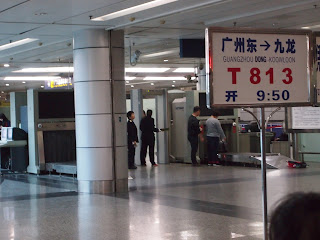
It's been such a long time since I last took a train in China. Looking forward to the trip!
Fast food restaurant in Guangzhou train station was Chinese style with Bruce Lee on the sign.

The "international" train to Hong Kong leaves from upstairs. Saw many adverts for "男科醫院" here...
Never heard of 男科 in other countries...!

Waiting for the immigration gate to open. Come to think of it, this is my first time crossing a boarder on a train.

There are two kinds of trains between Guangzhou and Hong Kong. The China ones and Hong Kong ones.
Of course, I chose the China one!
Hong Kong trains use made-in-Japan carriages and it would be the same as any other ordinary train ride experiences.

I'm glad that the Soviet style uniforms are still alive!
I hope they won't "modernize" those communist-style uniforms because they are one of the tourist attractions for foreigners.
Although it's also true that British-style uniforms in Hong Kong do look good!

Very comfortable.
I love the color of seats and the design of the carpet!
It would just be the same as any train anywhere in the world without those Chinese characteristics.

No more conductors distributing hot water with a big kettle! (Sayang!)
It would have been more environmentally friendly than distributing bottled water, which many passengers don't drink anyway.
In China, people USED TO bring their own cups. In other countries, people are JUST STARTING to do so for environmental concerns.
By the way, I was told off by this conductor for taking pictures in the train!

Guangdong must be one of the best part of China. Clean and green!
Such a stark difference from typically arid and dusty landscape of the rest of mainland China!

Arrived in Shenzhen.
This ultra-modern city used to be a sleepy farming village until Deng Xiaoping came here in the early 80s.

The ultra-modern city landscape of China turns into a squeeky clean natural-park style countryside once the train enters Hong Kong.
In my opinion, one of the best legacy of the British rule in Hong Kong is the separation of commercial/residential areas with natural reserves.
If this was in Taiwan (or in mainland China for that matter), those green hills would already be teeming with fake-European-style residential towers, hot spring resorts, night markets and graveyards.

Arrived at Kowloon station (Hung Hom).
I realy like the traditional Chinese fonts used for signs in Hong Kong MTR. They are traditional, yet modern.

Hung Hom station looks like one of the more modern train stations in Europe. Big glass windows and metal roofs are really unsuitable for tropical weather and wastes a lot of electrcity for airconditioning.
But I think the European aesthetics are still very much alive in Hong Kong. And they have enough money to afford to look good, I think!



